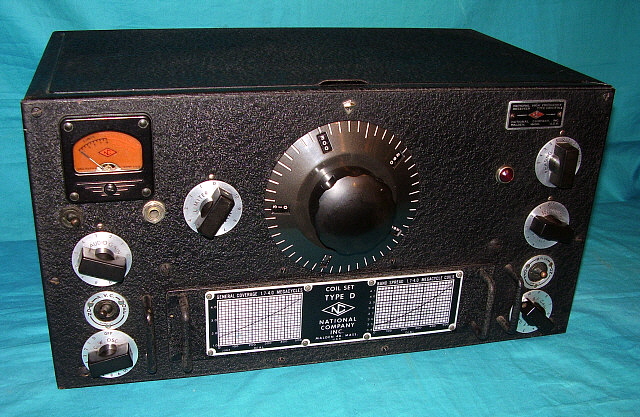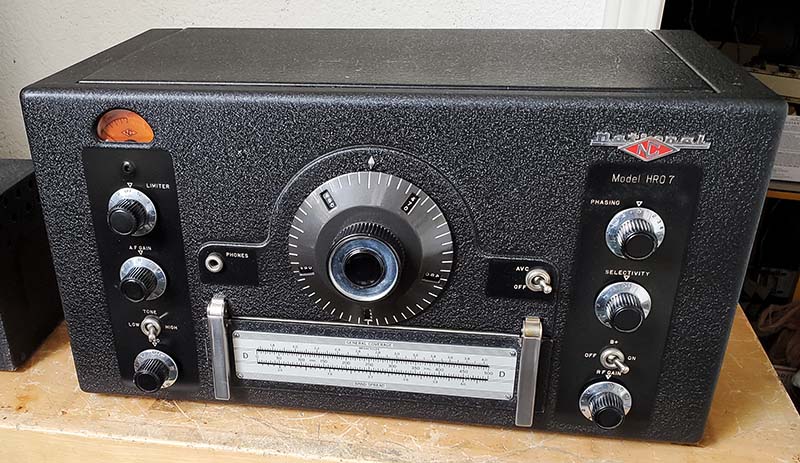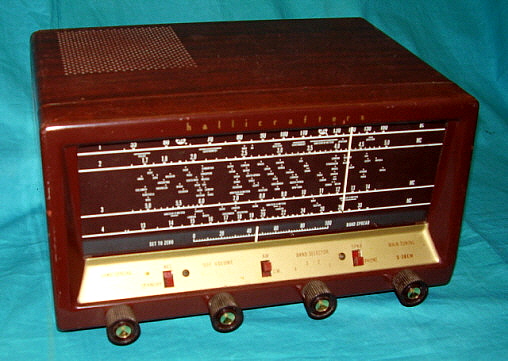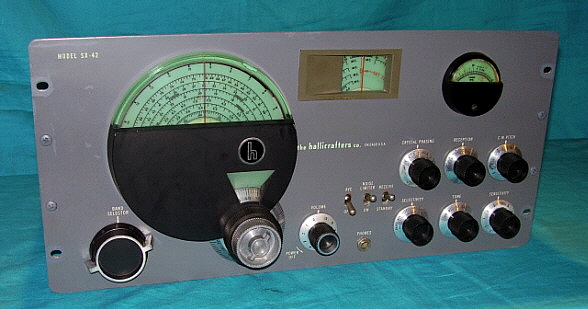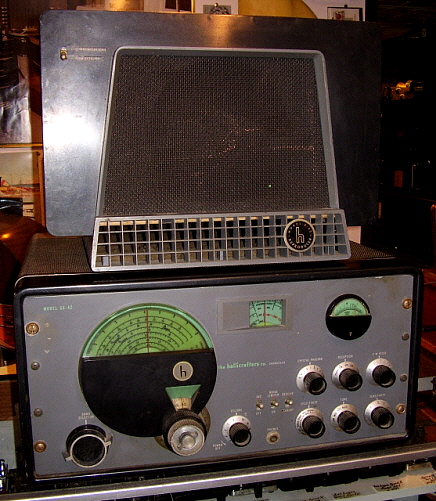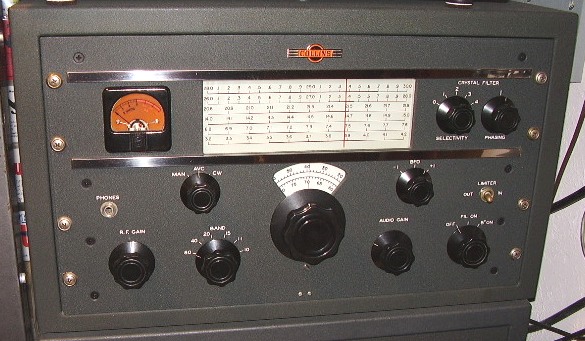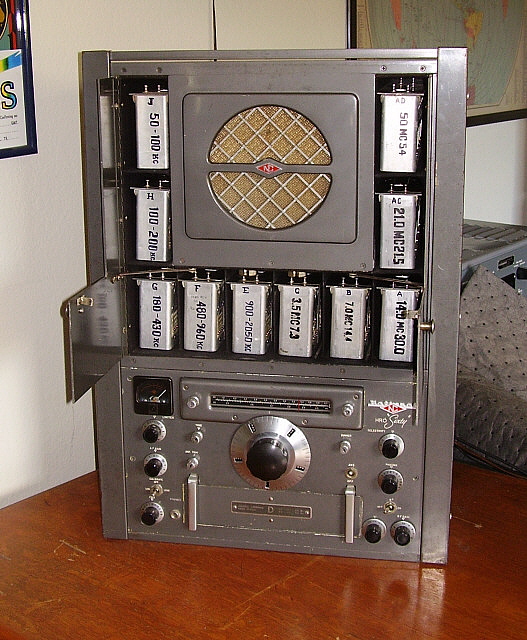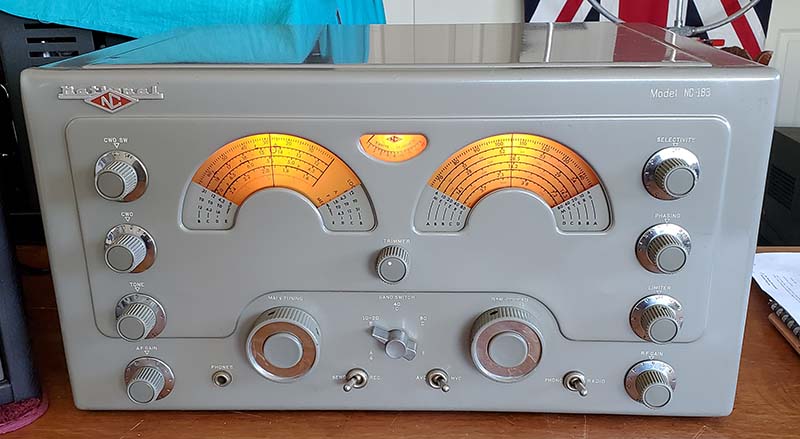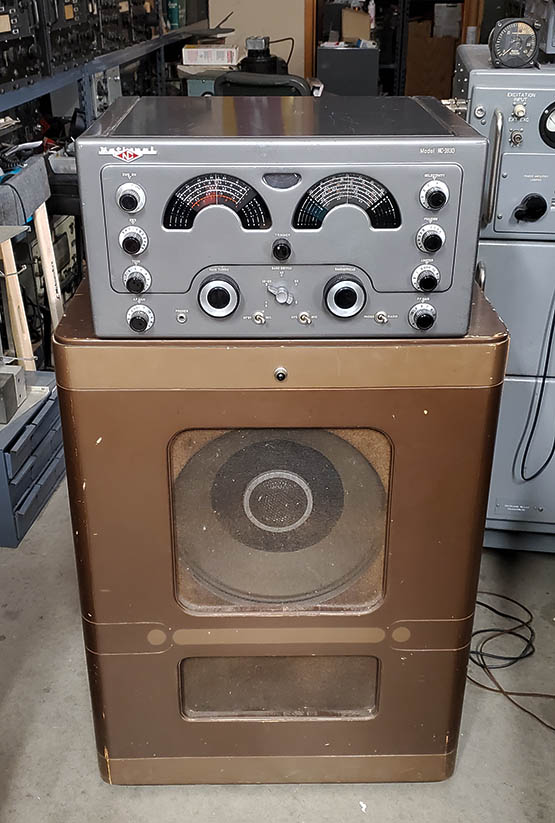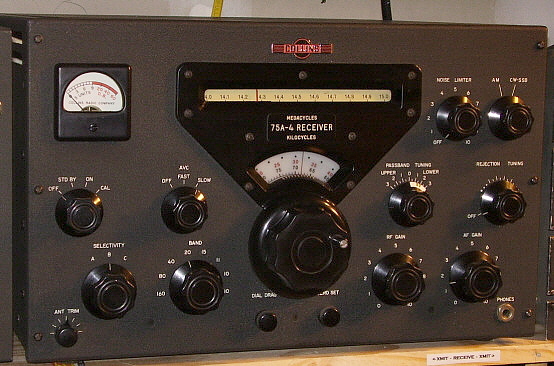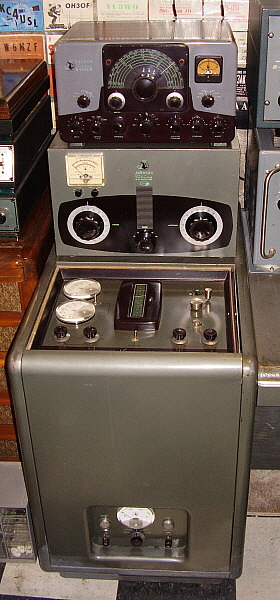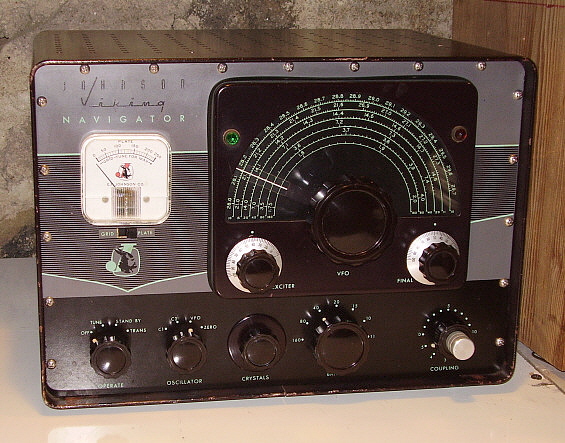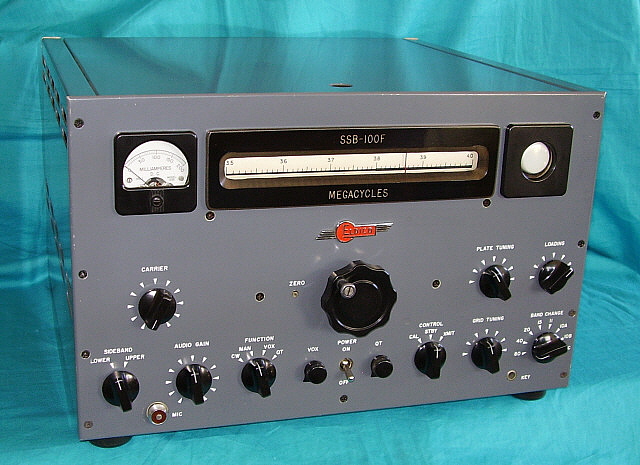| SN 616 was my main transmitter for many years and has
proven to be a super-flexible unit capable of high power SSB and CW with
reduced power AM and RTTY communications. There was a 13-year time
period from 1980 up to early 1993 when the KWS-1 was in storage inside a
fairly large, well-insulated pump house on our Minden, Nevada property back then. It managed to
survive this neglect without any issues since the pump house was
very dry and well-insulated (never got below freezing and never
got any warmer than about 80F - and it was dark, unless I opened
the door.) In fact, the KWS-1 has only had routine maintenance
performed on it over the years (meaning the KWS-1 is mostly all
original.) I did have to repair a broken flex connection on one
of the roller inductors a few years ago, also a broken wire in
the microphone connector. I now occasionally use the KWS-1 on AM on the
Vintage Military Radio Net where it provides a unique type of AM
for enthusiasts to hear - one selectable sideband with carrier.
The KWS-1 transmitters have a long association with military MARS stations and, of course, the SSB promotion that involved
Art Collins and the Air Force in the mid-fifties. My last set-up had sn: 616
set-up with a Collins Lab 51J-4 sn: 4723 as shown in the photo
above. The KWS-1
is certainly one of the best from the "Golden Age of Ham Radio."
OPERATIONAL NOTES: AM on the KWS-1 is
not without headaches - mostly in the form of "Critical Audio Reports"
from the BC-audio crowd. The KWS-1 will NEVER sound like
double-sideband AM and it will NEVER sound like high fidelity AM.
No matter how many times you describe the KWS-1's method of
generating an AM signal and the fact that it's a "single
sideband signal with reinserted carrier" you'll still run into
those listeners that expect AM BC Collins 20V-quality audio from
anything built by Collins (I don't know
why,...most of Collins' equipment was for communications.)
However, a few things performed during AM set-up can avoid most
"Critical Audio Reports" when using the KWS-1. Be sure to run
the carrier reinsertion (Carrier Level) so that it results in
about one-quarter unmodulated output power as compared to full power output.
This is usually about 150 watts of carrier and is usually
achieved at about 250mA of PA current. Use a known-accurate inline watt meter to be sure of the
carrier power output. Typical full power output DC on a KWS-1 will be
around 625 watts so one-quarter would be around 150 watts. Be sure to run the Audio Gain very low -
usually about 1 or so - and NEVER use the ALC - always keep the
ALC at full CCW in the AM mode. Be sure to monitor the PA Grid current -
it should never move from 0. Any grid current flowing will
create distortion. Even a minor fluctuation of the Grid Current
meter needle is indicating non-linearity and resulting
distortion. Keep the Audio Gain low (around 1) and avoid
excited, over-animated voice levels (if possible.) Use an
oscilloscope to monitor your modulation and watch the Grid
Current constantly. Following these suggestions will have your
KWS-1 producing "its type of AM" about as well as it can. You'll
still get "Critical Audio Reports" and sometimes you'll just
have to tell the "reporter" that the KWS-1 wasn't designed as a
high-level plate-modulated AM transmitter. It wasn't designed as an AM
broadcast transmitter. It's a high-power SSB transmitter that
can do AM in a method that produces "communications quality"
audio with a narrow bandwidth and THAT was what was important
for hams (and some limited military use) in
the 1950s. One other thing on the Collins procedure for
setting up for AM operation,...Collins really thought that
nobody was going to operate AM at one-quarter power when they
could operate full-power CW or SSB. So, their AM set-up is sort
of "try and see" how it will work. Basically, Collins has you
set-up for full power match to the antenna with the Carrier
Level producing about mid-scale grid current and PA current at
500mA. Then switch to AM and reduce the Carrier Level to show
250mA PA current and set the Audio Gain as required. The problem is how the
antenna load reacts to different carrier wave envelopes that are
produced at about 625 watts DC and 150 watts DC. I've found the
mismatch is noticeable and the efficiency is greatly reduced at
low power. It might be the antenna types that I use, "tuned
dipoles" with Z-matching, but I doubt it. What I do is to follow the Collins set-up but at the
point where I've reduced the Carrier Level for 250ma of PA
current, I then readjust the PA Tuning for the correct "dip" and
then I might adjust the PA Loading slightly and "re-dip" for the
best antenna match (making sure the SWR is still 1:1.) I've found that with the approach of
"retuning" after the reduction of carrier injection the KWS-1 PA
current is very stable and rarely needs to be adjusted after
setting it lower, to about 230mA. I actually have to reduce the
PA current (Carrier Level) for best ratio of Audio modulation to
Carrier Level. This results in an increase in output power to
about 175 watts with with a reduction in PA current to 230mA, in
other words, better efficiency since the PA input power is less
(230mA x 2KV rather than 500ma x 2KV.) Also, much better stability and
the audio modulation is very high with no grid current showing.
However, this is how my KWS-1 tunes using matched "tuned" dipole
antennas. Experimentation will determine if your KWS-1 on AM
with your antenna will react the same way.
More complaints are to be expected in modes other than AM.
Especially nowadays when the majority of hams are using modern
transceivers and expect absolutely no drift. The stock KWS-1
will
drift. In the 1950s through the early 1970s, the slight <1kc
drift that the KWS-1 exhibits during a QSO was not considered a
problem because every ham used separate receiver-transmitter
setups and a slight retuning of the receiver was normal
operating procedure. Besides, the KWS-1's <1kc drift was so much better than most other rigs
at the time. But,
today any frequency drift is unacceptable and you're likely to
receive a "critical frequency stability" report when operating
some modes. Some KWS-1 users will employ a synthesizer as an
external VFO or use a DSO (digitally synthesized oscillator) device at the EXT. VFO input to keep
the KWS-1 at "zero drift." The only mode where the "stock
f drift"
isn't noticed is on AM. SSB will garner complaints and RTTY
using a stock KWS-1 is
impossible anymore (in the 1970s, I ran this KWS-1 at reduced
power doing "real machine" RTTY with no problems. Not anymore!
An attempt at RTTY in 2022 was a disaster because of the "zero
drift" necessity when communicating with modern transceivers
that have a built-in RTTY mode. Nowadays, when operating RTTY, a
drift of 20 or 30 hertz will put your FSK signal out of the
filter's bandwidth, so very little drift can be tolerated in the
RTTY mode anymore. Back in the 1970s, I used to have to keep
retuning the receiver during a RTTY QSO due to the transmitter
drift on the other end. This was NORMAL,...then. That's why ALL
of the TUs had keying indicators for Mark and Space or
oscilloscope displays,...so you could visually see the proper
keying. And, if you had some sense of pitch and did monitor the
signal, you could hear the drift happening. Older RTTY TUs were more forgiving and many
military TUs worked on just one audio frequency and any deviation was
part of the Baudot code being sent, so drift wasn't too much of
an issue.) CW QSOs are so short with very short
exchanges that the KWS-1 doesn't have time to drift much.
Most KWS-1 owner-users believe that excessive heat from the PA box being so
near the PTO is the cause of the f drift. Modifications include fans and adding insulation on the exterior
of the PA box near the PTO (the PA box originally had its
interior lined with fiberglass insulation but in humid
environments the fiberglass took on moisture resulting in
arcing. There was an ECO to remove the fiberglass from inside
all KWS-1 transmitters that were worked on by Collins dealers.
However this original insulation may have kept the PA Box heat
away from the PTO.) What I've found is that the small
function relay is mounted on the same aluminum bracket that's
used as part of the PTO mounting. The vibration of the relay
"clicking" on and off with the T-R function will cause a very
slight "bump" each time in the PTO frequency. That
"bump" seems to add up over the
duration of a QSO. I noticed this when operating RTTY in the
mid-1970s. Careful experimentation showed that the PTO frequency
change only happened on the T-R operation and there really
wasn't any drift otherwise. My solution was to add some rubber cushions to the
mounting of the relay and that seemed to cure the problem.
However, that was then. Nowadays, fifty years later, it seems
other minor problems are
also creeping into the KWS-1's original components and that's
affecting its ability to stay on frequency. The BEST and EASIEST solution to the
drift problem is the use of an external
modern synthesizer device connected to the EXT. VFO input. It's
easy and it's
non-invasive.
|

